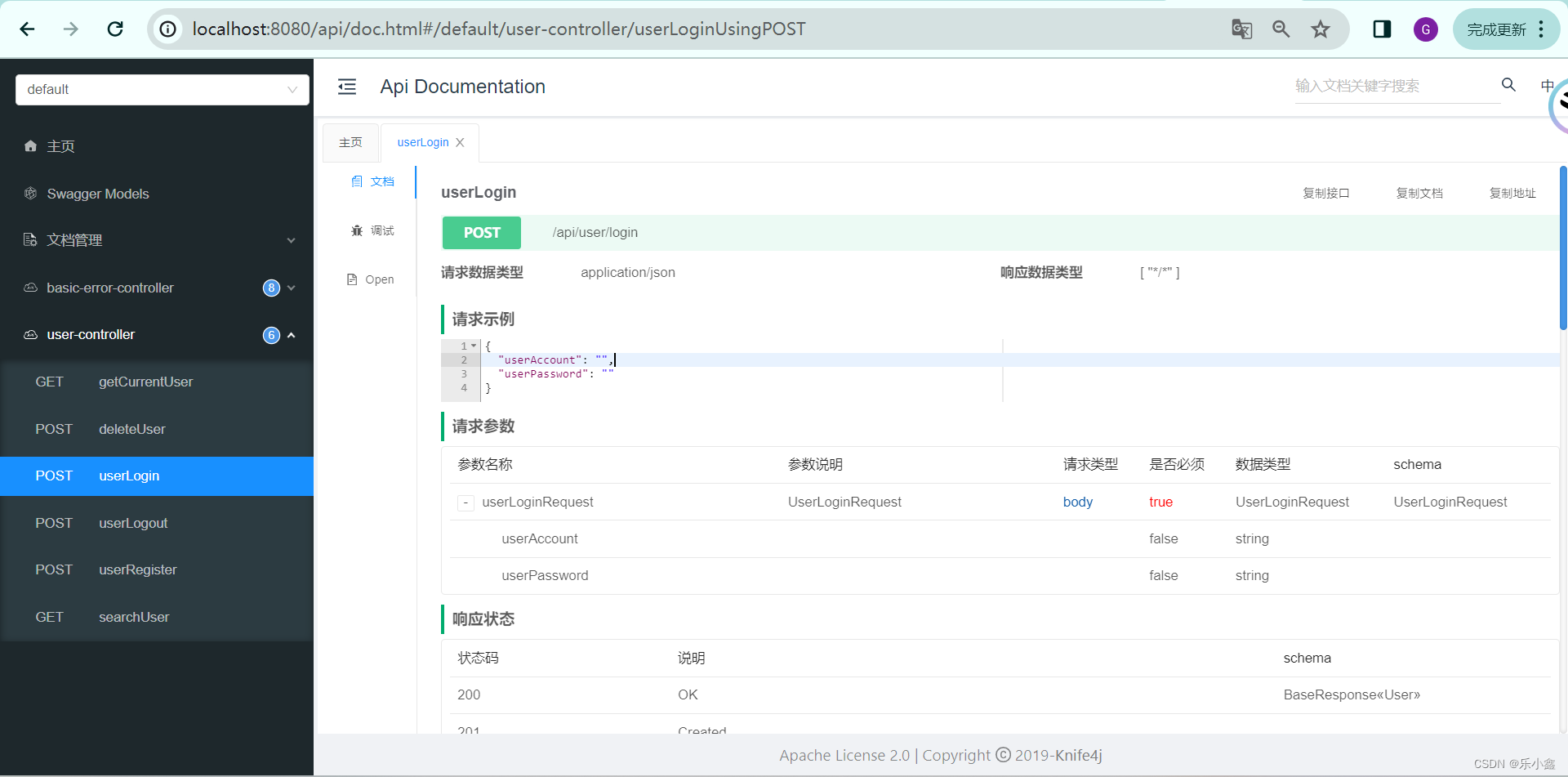Java 后端整合 Swagger 和 Knife4j 接口文档
发布时间:2024年01月14日
一、接口文档的介绍
1. 什么是接口文档?
-
接口信息:请求参数、响应参数、接口地址、接口名称、请求类型、请求格式、备注
2. 谁在使用接口文档?
-
提供方:后端开发者或者项目负责人
-
使用方:后端和前端开发者
3. 为什么需要接口文档?
-
项目交接时便于接手新项目的开发人员通过查看接口文档熟悉项目,便于大家参考和查阅,便于项目的沉淀和维护
-
便于前后端开发对接,可以看作前后端联调的介质
-
好的接口文档接口在线调试、在线测试,作为工具来提高开发测试的效率
4. 怎么实现接口文档?
-
手写:腾讯文档、Markdown 笔记
-
自动化生成接口文档:自动根据项目代码生成完整的文档或在线调试的网页
-
Swagger
-
Postman(侧重于接口管理)
-
国内:Apifox、Apipost、Eolink
-
5. Swagger 的原理
-
引入依赖(Swagger 或 Knife4j)
-
自定义 Swagger 配置类
-
指定需要生成接口文档的代码位置(Controller)
-
注意!线上环境不要向外部暴露接口!!
-
解决方式:在 SwaggerConfig 配置文件开头添加以下限定配置,注明仅在部分环境开启接口文档
@Profile({"dev", "test"}) -
-
启动项目之后,直接访问自动生成的接口文档即可
6. 使用接口文档的技巧
- 在 controller 方法上添加以下注解来自定义生成的接口描述信息:使接口文档更加清晰易读
- @Api:用于标识一个 Controller 类,表示该类中的接口将会被包含在生成的接口文档中
- @ApiImplicitParam(name = "name",value = "姓名",required = true):用于描述一个方法的参数,通过指定参数名、值和是否必需来生成接口文档中的参数描述
- @ApiOperation(value = "向客人问好") :用于描述一个方法的作用,通过指定方法的名称和详细描述来生成接口文档中的接口描述
二、Java 整合 Knife4j?的详细步骤
参考官方文档:Knife4j · 集Swagger2及OpenAPI3为一体的增强解决方案. | Knife4j (xiaominfo.com)
1. 添加依赖
- 在 pom.xml 中引入 Knife4j 的依赖
- Knife4j是一个集Swagger2 和 OpenAPI3 为一体的增强解决方案
<dependency>
<groupId>com.github.xiaoymin</groupId>
<artifactId>knife4j-spring-boot-starter</artifactId>
<version>3.0.3</version>
</dependency>
2. 添加配置类
package com.example.usercenter.config;
import org.springframework.context.annotation.Bean;
import org.springframework.context.annotation.Configuration;
import org.springframework.context.annotation.Profile;
import springfox.documentation.builders.ApiInfoBuilder;
import springfox.documentation.builders.PathSelectors;
import springfox.documentation.builders.RequestHandlerSelectors;
import springfox.documentation.service.ApiInfo;
import springfox.documentation.service.Contact;
import springfox.documentation.spi.DocumentationType;
import springfox.documentation.spring.web.plugins.Docket;
import springfox.documentation.swagger2.annotations.EnableSwagger2WebMvc;
/**
* 自定义 Swagger 接口文档的配置
*
* @author <a href="https://github.com/liyupi">程序员鱼皮</a>
* @from <a href="https://yupi.icu">编程导航知识星球</a>
*/
@Configuration
@EnableSwagger2WebMvc
@Profile({"dev", "test"})
public class SwaggerConfig {
@Bean(value = "defaultApi2")
public Docket defaultApi2() {
return new Docket(DocumentationType.SWAGGER_2)
.apiInfo(apiInfo())
.select()
// 这里一定要标注你控制器的位置
.apis(RequestHandlerSelectors.basePackage("com.yupi.yupao.controller"))
.paths(PathSelectors.any())
.build();
}
/**
* api 信息
* @return
*/
private ApiInfo apiInfo() {
return new ApiInfoBuilder()
.title("逐浪用户中心")
.description("逐浪用户中心接口文档")
.termsOfServiceUrl("https://github.com/lvxinxinL")
.contact(new Contact("乐小鑫","https://github.com/lvxinxinL","20890@qq.com"))
.version("1.0")
.build();
}
}
3. 启动项目,查看接口文档(报错解决记录)
- 踩坑:启动项目,遇到以下报错
org.springframework.context.ApplicationContextException: Failed to start bean 'documentationPluginsBootstrapper'; nested exception is java.lang.NullPointerException- 报错原因:Springboot2.6 以后将 SpringMVC 默认路径匹配策略从 AntPathMatcher 更改为 PathPatternParser,导致出错
- 解决方法:在 application.yml 中添加以下配置修改 SpringMVC 的默认路径匹配策为 AntPathMatcher
spring:
mvc:
pathmatch:
matching-strategy: ANT_PATH_MATCHER- 访问 localhost:8080/doc.html 查看 Knife4j 生成的接口文档

4. 使用接口文档进行调试
- 以用户登录为例
- 点击要调试的接口 userLogin
- 点击调试,输入请求参数
- 发送请求
- 查看请求响应内容

?
文章来源:https://blog.csdn.net/m0_74059961/article/details/135573030
本文来自互联网用户投稿,该文观点仅代表作者本人,不代表本站立场。本站仅提供信息存储空间服务,不拥有所有权,不承担相关法律责任。 如若内容造成侵权/违法违规/事实不符,请联系我的编程经验分享网邮箱:chenni525@qq.com进行投诉反馈,一经查实,立即删除!
本文来自互联网用户投稿,该文观点仅代表作者本人,不代表本站立场。本站仅提供信息存储空间服务,不拥有所有权,不承担相关法律责任。 如若内容造成侵权/违法违规/事实不符,请联系我的编程经验分享网邮箱:chenni525@qq.com进行投诉反馈,一经查实,立即删除!